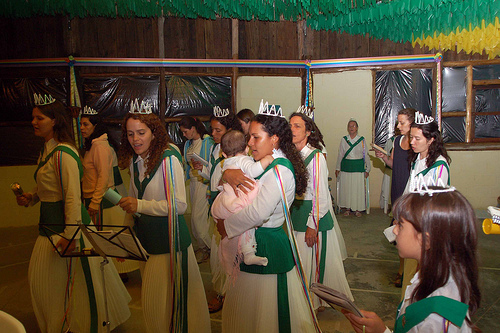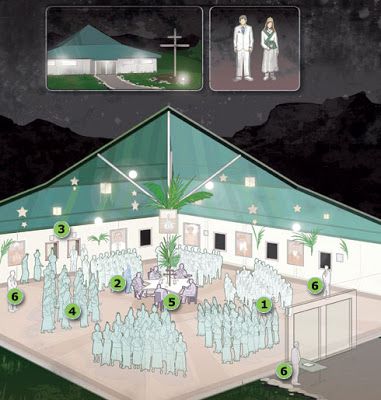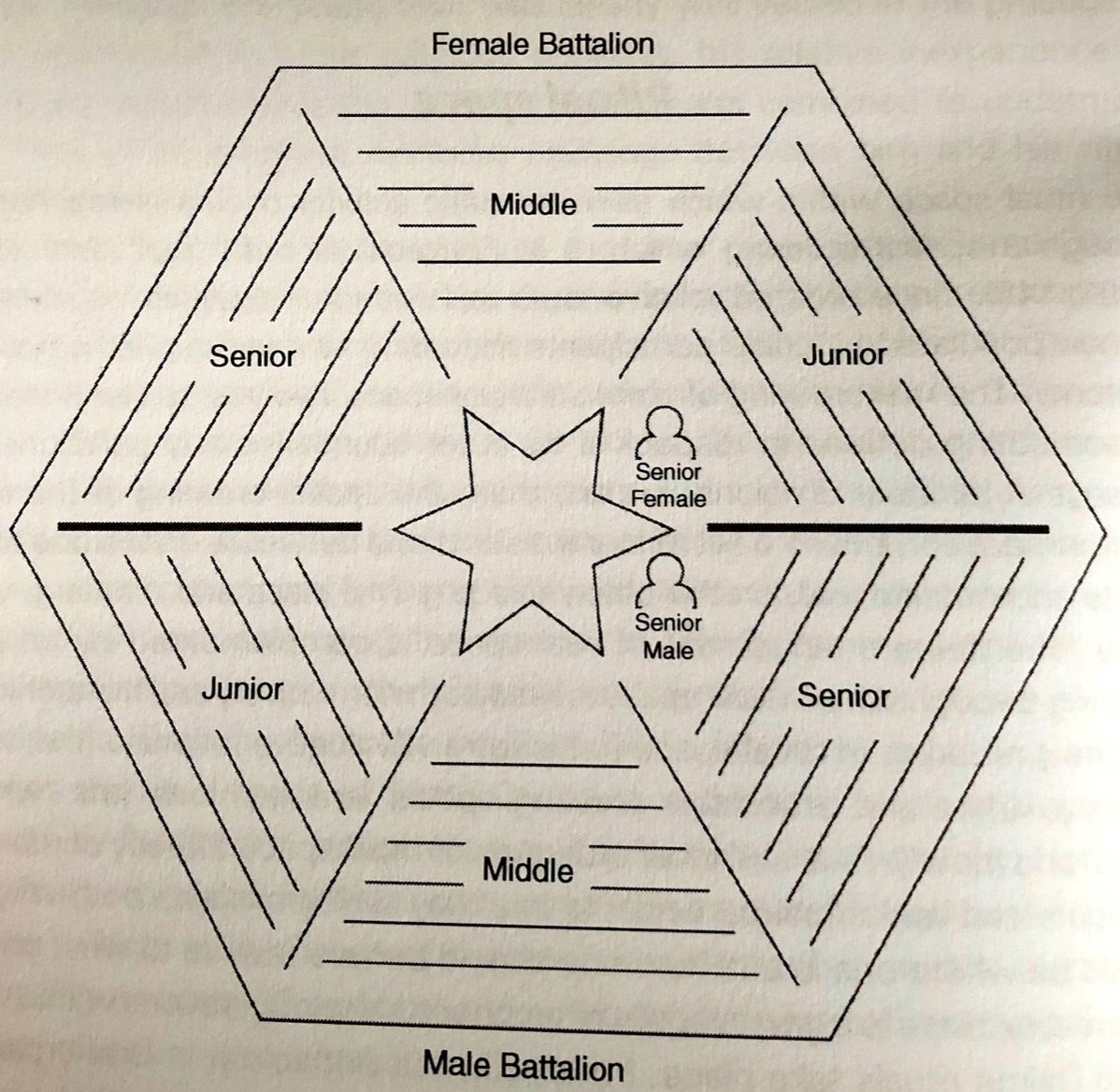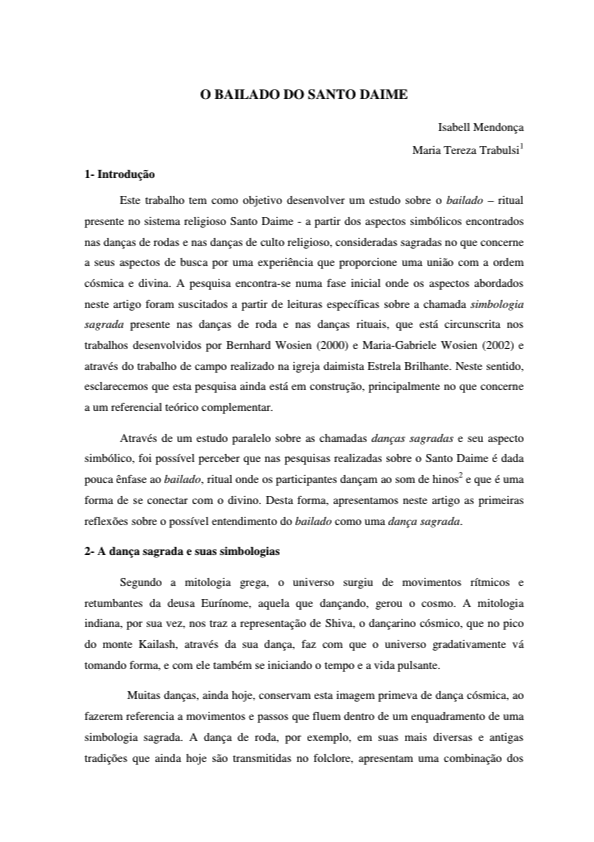
O Bailado
Os fardados devem atender a chamada para a abertura do despacho do Santo Daime. Depois devem se dirigir aos seus locais de baile, enquanto os fiscais e demais encarregados dos turnos de serviço vão para os seus setores. Devem ser formadas filas de fardados por ordem de altura, os homens à esquerda e a mulheres à direita. Em seguida, os não-fardados e os visitantes.
Depois dos fardados, os paisanos tomam o Santo Daime e ocupam seus lugares, seja nos bancos ou nos últimos lugares da fila do baile, atrás dos fardados.
Todos devem permanecer em seus lugares. O fardado só poderá se ausentar do Salão durante o período de três hinos. A ausência deve ser comunicada ao companheiro da direita na fila. Se possível, esperar o final do hino para se retirar. Prolongando-se a ausência além desse prazo, a fila deve ser preenchida da esquerda para direita.
Os ritmos do bailado são marcha (2 por 2), valsa (1 por 1) e mazurca (ternário) e o movimento iguala-se ao balanço do mar. O bailado inicia-se após a primeira estrofe do hino, a partir do movimento do comandante que dá o primeiro passo à esquerda.
The ballroom dancing became the Santo Daime dance: the Bailado. The Queen of the Forest ordered that the Bailado would last 12 hours according to the cycle of the sea tides.
The purpose of the Bailado is not limited to straightening community ties. The dance is defined as a collective effort to manipulate the energy. The ceremony creates an energy container with an access to a parallel reality. The Bailado serves as a modulator of a revelations of the Santo Daime tea. In order to prevent psychological disintegration. The Bailado anchors the participants as they go through different levels of consciousness. A possible crisis brought upon the intensity of the experience is channeled through the dance. Participants focus on their co-ordination to avoid mental distractions. The kinesthetic alchemy of the Daime dance consists of concentrating on opposite poles, that explains the separation of the men and women. The Bailado forms a pattern that creates a human generator. Its choreography is meant to generate sufficient energy to sustain the healing process in the parallel reality.
The purpose of the Bailado is not limited to straightening community ties. The dance is defined as a collective effort to manipulate the energy. The ceremony creates an energy container with an access to a parallel reality. The Bailado serves as a modulator of a revelations of the Santo Daime tea. In order to prevent psychological disintegration. The Bailado anchors the participants as they go through different levels of consciousness. A possible crisis brought upon the intensity of the experience is channeled through the dance. Participants focus on their co-ordination to avoid mental distractions. The kinesthetic alchemy of the Daime dance consists of concentrating on opposite poles, that explains the separation of the men and women. The Bailado forms a pattern that creates a human generator. Its choreography is meant to generate sufficient energy to sustain the healing process in the parallel reality.
A Santo Daime church represents the physical space where the majority of rituals take place. The church space incorporates a number of unique characteristics, the first being the shape of the structure itself; Santo Daime churches tend to be hexagonal buildings with waist high open walls on all but the far wall from where Daime is served located apposite of the main entrance. Although some churches do not have any surrounding walls, such as is the case in Céu do Mapiá, parishioners enter from all sides, however, next to the main entrance there typically is a large cross and bell. The walls of the church, if existing at all, are only waist-high which gives the space a very open feel. In Céu do Mapiá the front entrance is from the west although I am not convinced that the physical orientation of the church bears any particular significance, as is the custom in other Christian churches whose doors face west (and thus the altar on the opposite wall faces East towards Jerusalem, for those churches located in the western hemisphere). I conclude this based on the fact that the opposite is true for the Rio de Janeiro church, whose entrance is from the east. The ceiling can be made of various materials such as straw or awning, but is typically round or hexagonal, and cone shaped. The floor is demarcated with paint or tape in six equal triangular sections, three for the women's side always to the left of the main entrance, and three for the men's side. The three triangular sections on each side are next to each other and are themselves divided further in rows. Each row is reserved for participants according to various characteristics; the older members who are married will populate the smallest first row closest to the center table. The rows closer to the back are reserved for the visitors and non-fardados, or those not baptized in the Santo Daime tradition. Each of the three sections on either the male or the female side of the hall is also divided by seniority. The more senior members sit in the section farthest to the right, and the youngest members are to the section to the left. The individual who monitor the space and serves the Daime is called "Fiscal", and they also have the duty of assigning members to their appropriate sections, and continue to do so throughout the night as more members typically join.
In the center of the hall there is always a table in the shape of a hexagonal star. In the center of the table there is typically a Cross of Caravacca, candles, cups of water for drinking, and framed icons of the founders and elders of Santo Daime. Around the table are six chairs reserved for three men and three women, typically elders of the congregation. Behind the elders on the male side sit the musicians, always including guitar players, while on the female side the front rows are reserved for the main female singers who begins each hymnal and sets the tone for the musicians. The singers maintain a very important and powerful role in the church and in their communities, so central that I devote to them their own chapter in following pages. The main singer is called the "Puxadora" (translating literally as the one that pulls), eluding to her role as the one who guides the tone and the energy of the mass. This is a role of great pride, honor, prestige, talent, and power.
To the side of the church opposite of the entrance is a small room resembling what can best be described as a kitchen counter, from where Daime is served, always by men who hold the important role of monitor (Fiscal). These men not only oversee the serving of Daime but also ensure order and safety of the members. They remain vigilant throughout the works to ensure that all present are safe, and that no one is absent from the procession for too long; recognizing that the intoxication due to the consumption of Daime typically leads to vomiting, nausea, diarrhea, perfuse sweating, or alternately cold spells that manifest themselves in severe uncontrollable shivering, it is permissible to leave the group works to appropriately address any of these issues. However, the fiscals' duties are primarily to serve Daime, ensure safety and order, and maintain all members in the group processions as much as possible. This sometimes involves very direct insistence for the members dealing with any one or all of these uncomfortable conditions to excuse themselves and sit out only as long as it is absolutely necessary, but then promptly rejoin the group. The fiscal will also judge for himself, or be told by individual members, how much Daime to pour into each individual’s cup. The fiscal is not shy about suggesting one to consume more Daime if the observed effects are mild according to him. The fiscal is also there to help those members suffering the most severe side effects of ayahuasca: this can involve bringing a blanket, tending to those participants who are so taken by the ayahuasca that they yell and/or convulse, and ultimately making sure all present return to their starting spot and continue participating in the singing. The women have their own fiscal who does the same duties save for serving the Daime. The preferred vocabulary in Portuguese associated with the act of consumption of ayahuasca is to take (tomar) as opposed to drink (beber).
The walls and ceiling of the church are typically adorned with photographs and posters of various individuals associated with founding or guiding the Santo Daime church. A picture of Irineu Serra and his disciple Sebastião Mota Melo are always present in the church and typically are found on the main center table. The images of other influential individuals such as "Madrinha Rita", the wife of Sebastião Mota Melo, and "Padrinho Alfredo", one of the sons of Sebastião and Rita who resides in Céu do Mapiá from where he leads the ICEFLU organization. Alongside the walls of the church or directly behind the members are chairs or benches that allow for members enduring the hardest effects of the psychoactive brew to take a respite from the mass and regain their strength. There is also a water dispenser on each side of the church, as well as buckets placed all around the back walls. These buckets come in good use during the most disagreeable effects of Daime on the stomach which typically lead to severe nausea and vomiting. Vomiting during processions is expected and never stigmatized. In fact, vomiting some members find desirable in that it represents a purge, or cleansing from the inside, and is thought of as a welcome sign that the Daime is having a strong effect on the body. The fiscals also tend to rinsing these bowls out in between uses, which they do with a great deal of understanding and compassion toward the nauseated members typically incapable of completing this task themselves.
In countries where the Santo Daime community is still numerically small, or where ayahuasca does not hold legal status, Santo Daime works are typically clandestine in nature and conducted in whatever locations the local congregation finds to be suitable. In Los Angeles, for example, the Santo Daime congregation has had a particularly challenge of finding a permanent physical location to hold their works in. Privacy, silence, and seclusion are the main traits of shared by all previously used locales.
In the center of the hall there is always a table in the shape of a hexagonal star. In the center of the table there is typically a Cross of Caravacca, candles, cups of water for drinking, and framed icons of the founders and elders of Santo Daime. Around the table are six chairs reserved for three men and three women, typically elders of the congregation. Behind the elders on the male side sit the musicians, always including guitar players, while on the female side the front rows are reserved for the main female singers who begins each hymnal and sets the tone for the musicians. The singers maintain a very important and powerful role in the church and in their communities, so central that I devote to them their own chapter in following pages. The main singer is called the "Puxadora" (translating literally as the one that pulls), eluding to her role as the one who guides the tone and the energy of the mass. This is a role of great pride, honor, prestige, talent, and power.
To the side of the church opposite of the entrance is a small room resembling what can best be described as a kitchen counter, from where Daime is served, always by men who hold the important role of monitor (Fiscal). These men not only oversee the serving of Daime but also ensure order and safety of the members. They remain vigilant throughout the works to ensure that all present are safe, and that no one is absent from the procession for too long; recognizing that the intoxication due to the consumption of Daime typically leads to vomiting, nausea, diarrhea, perfuse sweating, or alternately cold spells that manifest themselves in severe uncontrollable shivering, it is permissible to leave the group works to appropriately address any of these issues. However, the fiscals' duties are primarily to serve Daime, ensure safety and order, and maintain all members in the group processions as much as possible. This sometimes involves very direct insistence for the members dealing with any one or all of these uncomfortable conditions to excuse themselves and sit out only as long as it is absolutely necessary, but then promptly rejoin the group. The fiscal will also judge for himself, or be told by individual members, how much Daime to pour into each individual’s cup. The fiscal is not shy about suggesting one to consume more Daime if the observed effects are mild according to him. The fiscal is also there to help those members suffering the most severe side effects of ayahuasca: this can involve bringing a blanket, tending to those participants who are so taken by the ayahuasca that they yell and/or convulse, and ultimately making sure all present return to their starting spot and continue participating in the singing. The women have their own fiscal who does the same duties save for serving the Daime. The preferred vocabulary in Portuguese associated with the act of consumption of ayahuasca is to take (tomar) as opposed to drink (beber).
The walls and ceiling of the church are typically adorned with photographs and posters of various individuals associated with founding or guiding the Santo Daime church. A picture of Irineu Serra and his disciple Sebastião Mota Melo are always present in the church and typically are found on the main center table. The images of other influential individuals such as "Madrinha Rita", the wife of Sebastião Mota Melo, and "Padrinho Alfredo", one of the sons of Sebastião and Rita who resides in Céu do Mapiá from where he leads the ICEFLU organization. Alongside the walls of the church or directly behind the members are chairs or benches that allow for members enduring the hardest effects of the psychoactive brew to take a respite from the mass and regain their strength. There is also a water dispenser on each side of the church, as well as buckets placed all around the back walls. These buckets come in good use during the most disagreeable effects of Daime on the stomach which typically lead to severe nausea and vomiting. Vomiting during processions is expected and never stigmatized. In fact, vomiting some members find desirable in that it represents a purge, or cleansing from the inside, and is thought of as a welcome sign that the Daime is having a strong effect on the body. The fiscals also tend to rinsing these bowls out in between uses, which they do with a great deal of understanding and compassion toward the nauseated members typically incapable of completing this task themselves.
In countries where the Santo Daime community is still numerically small, or where ayahuasca does not hold legal status, Santo Daime works are typically clandestine in nature and conducted in whatever locations the local congregation finds to be suitable. In Los Angeles, for example, the Santo Daime congregation has had a particularly challenge of finding a permanent physical location to hold their works in. Privacy, silence, and seclusion are the main traits of shared by all previously used locales.


O bailado deve acompanhar o compasso da música, sem arrastar nem acelerar. Ele se caracteriza pela ordem, não há improvisos, nem coreografias frenéticas. O conjunto harmônico de todos os participantes forma uma corrente mágica, que nos inspira ao movimento do Cosmos. Deve se evitar trejeitos e movimentos exagerados que destoem do padrão apresentado pela corrente. Ele é a vitrine do trabalho espiritual de cada um.
O bailado é acompanhado pelo ritmo de batidas de “maracá ” feitos com pequenas latas contendo esferas e cabo de madeira. O maracá deve estar afinado convenientemente. Todo o fardado deve ter um maracá, faz parte da farda. O fardado deve ter consciência, que no trabalho espiritual, o maracá é um instrumento de poder, não deve deixa-lo no chão, ou joga-lo em qualquer lugar. O fardado deve saber tocar o maracá adequadamente, dentro do ritmo exigido pelo hino. Não deve ser posicionado para baixo, e sim para cima, na altura do peito, tocando levemente na outra mão, marcando melhor o ritmo da batida
É necessário que haja tolerância acompanhada de instrução para a adaptação dos novatos.É fundamental que os fiscais tenham tolerância para instruí-los de forma delicada e amorosa.
Pela separação energética e complementar entre homens e mulheres, sente-se o Tão (o yin e o yang) numa grande circulação de energia em movimento.
Através da dança nos conectamos com o Cosmos, formamos um único corpo, harmonizamos o transe, formando uma mandala humana e no centro a força do Altar, do Cruzeiro.
As filas de bailado são dispostas de acordo com a altura dos participantes, com os membros fardados ocupando as filas da frente.
As posições nas filas de bailado não devem se tornar pontos de afirmações de ego ou símbolo de poderes especiais. Todos devem compor-se em seus lugares de acordo com os critérios que forem estabelecidos.
O lugar vago na corrente dever ser imediatamente preenchido e o retorno feito após a conclusão do hino.
Todo membro fardado, na corrente, é um Soldado da Rainha, que tem a responsabilidade de um trabalho de muita seriedade. Deve cantar e bailar durante todo o hinário, salvo impedimento justificado.
O bailado é acompanhado pelo ritmo de batidas de “maracá ” feitos com pequenas latas contendo esferas e cabo de madeira. O maracá deve estar afinado convenientemente. Todo o fardado deve ter um maracá, faz parte da farda. O fardado deve ter consciência, que no trabalho espiritual, o maracá é um instrumento de poder, não deve deixa-lo no chão, ou joga-lo em qualquer lugar. O fardado deve saber tocar o maracá adequadamente, dentro do ritmo exigido pelo hino. Não deve ser posicionado para baixo, e sim para cima, na altura do peito, tocando levemente na outra mão, marcando melhor o ritmo da batida
É necessário que haja tolerância acompanhada de instrução para a adaptação dos novatos.É fundamental que os fiscais tenham tolerância para instruí-los de forma delicada e amorosa.
Pela separação energética e complementar entre homens e mulheres, sente-se o Tão (o yin e o yang) numa grande circulação de energia em movimento.
Através da dança nos conectamos com o Cosmos, formamos um único corpo, harmonizamos o transe, formando uma mandala humana e no centro a força do Altar, do Cruzeiro.
As filas de bailado são dispostas de acordo com a altura dos participantes, com os membros fardados ocupando as filas da frente.
As posições nas filas de bailado não devem se tornar pontos de afirmações de ego ou símbolo de poderes especiais. Todos devem compor-se em seus lugares de acordo com os critérios que forem estabelecidos.
O lugar vago na corrente dever ser imediatamente preenchido e o retorno feito após a conclusão do hino.
Todo membro fardado, na corrente, é um Soldado da Rainha, que tem a responsabilidade de um trabalho de muita seriedade. Deve cantar e bailar durante todo o hinário, salvo impedimento justificado.

As filas do bailado devem ser dispostas de acordo com a altura dos participantes, do mais alto para o mais baixo, da direita para a esquerda da fila do lado dos homens e da esquerda para a direita da fila pelo lado das mulheres. Os retângulos disponíveis para o bailado devem medir aproximadamente 70 x 30cm.
A cabeceira da mesa se encontra frente à porta de acesso ao Salão que geralmente é voltado para o leste. À esquerda da cabeceira da mesa ficam os homens, e a direita as mulheres. Seguem-se os rapazes e as moças, as meninas e os meninos.
O setor das crianças, como é sempre mais vazio, recebe também visitantes nos dias em que a Igreja está mais cheia.
O bailado se apresenta em três tipos básicos: valsa, marcha e mazurca. O bailado inicia-se após a primeira estrofe do hino, a partir do movimento do comandante que dá o primeiro passo à esquerda.
O bailado deve acompanhar o compasso da música, sem arrastar nem acelerar. O bailado é também uma vitrine do trabalho espiritual de cada um. Deve-se evitar trejeitos e movimentos exagerados que quebrem o padrão apresentado pela corrente.
É necessário que haja tolerância no caso dos novatos. Mas ela deve ser acompanhada de instrução para a adaptação dos mesmos às instruções de serviço. Porém, erros de compostura mais graves devem ser corrigidos e orientados desde o início.
O maracá deve estar afinado convenientemente. Devemos buscar como meta que todo fardado tenha um maracá e saiba tocá-lo adequadamente dentro do ritmo exigido pelo hino. O comando do trabalho poderá limitar o número de maracás, se assim julgar conveniente.
As filas de bailado são dispostas de acordo com a altura dos participantes, com os membros fardados ocupando as filas da frente.
As posições nas filas de bailado não devem se tornar pontos de afirmações de ego ou símbolo de poderes especiais. Todos devem compor-se em seus lugares de acordo com os critérios que forem estabelecidos
Todo membro fardado, na corrente, é um Soldado da Rainha, que tem a responsabilidade de um trabalho de muita seriedade. Deve cantar e bailar durante todo o hinário, salvo impedimento justificado.
A cabeceira da mesa se encontra frente à porta de acesso ao Salão que geralmente é voltado para o leste. À esquerda da cabeceira da mesa ficam os homens, e a direita as mulheres. Seguem-se os rapazes e as moças, as meninas e os meninos.
O setor das crianças, como é sempre mais vazio, recebe também visitantes nos dias em que a Igreja está mais cheia.
O bailado se apresenta em três tipos básicos: valsa, marcha e mazurca. O bailado inicia-se após a primeira estrofe do hino, a partir do movimento do comandante que dá o primeiro passo à esquerda.
O bailado deve acompanhar o compasso da música, sem arrastar nem acelerar. O bailado é também uma vitrine do trabalho espiritual de cada um. Deve-se evitar trejeitos e movimentos exagerados que quebrem o padrão apresentado pela corrente.
É necessário que haja tolerância no caso dos novatos. Mas ela deve ser acompanhada de instrução para a adaptação dos mesmos às instruções de serviço. Porém, erros de compostura mais graves devem ser corrigidos e orientados desde o início.
O maracá deve estar afinado convenientemente. Devemos buscar como meta que todo fardado tenha um maracá e saiba tocá-lo adequadamente dentro do ritmo exigido pelo hino. O comando do trabalho poderá limitar o número de maracás, se assim julgar conveniente.
As filas de bailado são dispostas de acordo com a altura dos participantes, com os membros fardados ocupando as filas da frente.
As posições nas filas de bailado não devem se tornar pontos de afirmações de ego ou símbolo de poderes especiais. Todos devem compor-se em seus lugares de acordo com os critérios que forem estabelecidos
Todo membro fardado, na corrente, é um Soldado da Rainha, que tem a responsabilidade de um trabalho de muita seriedade. Deve cantar e bailar durante todo o hinário, salvo impedimento justificado.

